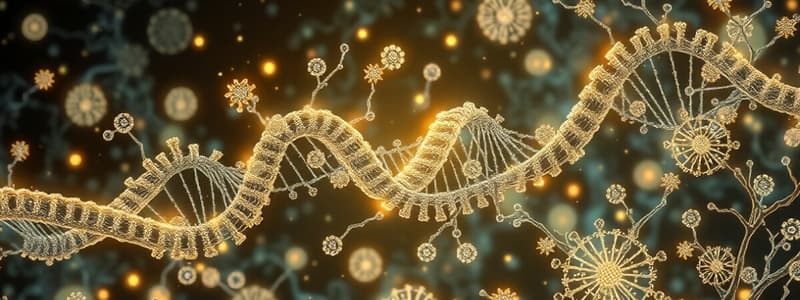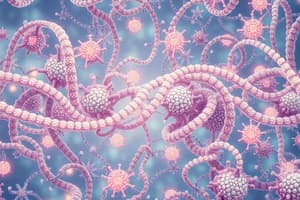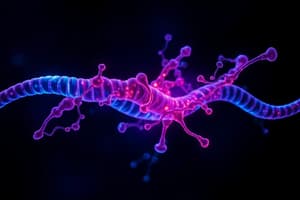Podcast
Questions and Answers
What role does transposase play in the genome?
What role does transposase play in the genome?
- It mediates the movement of transposable elements. (correct)
- It synthesizes RNA from DNA.
- It promotes the replication of DNA.
- It functions as a transcription factor.
Which element is primarily responsible for the initiation of transcription?
Which element is primarily responsible for the initiation of transcription?
- Silencer elements.
- TATA box. (correct)
- Enhancer elements.
- Response elements.
What distinguishes cis-acting elements from trans-acting factors?
What distinguishes cis-acting elements from trans-acting factors?
- Cis-acting elements are present on the same gene they regulate. (correct)
- Cis-acting elements interact with transcription factors.
- Cis-acting elements can regulate other genes.
- Cis-acting elements are produced by the gene being transcribed.
Which of the following is NOT a type of signaling molecule that binds to response elements?
Which of the following is NOT a type of signaling molecule that binds to response elements?
How do enhancers exert their regulatory effects on transcription?
How do enhancers exert their regulatory effects on transcription?
How do steroid hormones primarily affect gene expression?
How do steroid hormones primarily affect gene expression?
Which of the following correctly describes the role of CREB protein?
Which of the following correctly describes the role of CREB protein?
What is a common pharmacological mechanism used to treat inflammatory disorders with steroid drugs?
What is a common pharmacological mechanism used to treat inflammatory disorders with steroid drugs?
In the treatment of diabetes mellitus, how does insulin affect gene expression?
In the treatment of diabetes mellitus, how does insulin affect gene expression?
How do calcineurin inhibitors like cyclosporine work to suppress immune activity?
How do calcineurin inhibitors like cyclosporine work to suppress immune activity?
What is the primary outcome of alternative splicing and polyadenylation of mRNA?
What is the primary outcome of alternative splicing and polyadenylation of mRNA?
What mechanism is described by a change in a single nucleotide in mRNA leading to altered protein size?
What mechanism is described by a change in a single nucleotide in mRNA leading to altered protein size?
Which factor is NOT mentioned as influencing the stability of mRNA?
Which factor is NOT mentioned as influencing the stability of mRNA?
What role do microRNAs play in post-transcriptional regulation?
What role do microRNAs play in post-transcriptional regulation?
At what level do most eukaryotic translational controls exert their effects?
At what level do most eukaryotic translational controls exert their effects?
What function do lysosomal enzymes primarily serve in cellular health?
What function do lysosomal enzymes primarily serve in cellular health?
Which of the following statements about eukaryotic initiation factor 2 (eIF2) is accurate?
Which of the following statements about eukaryotic initiation factor 2 (eIF2) is accurate?
How are lysosomal enzymes produced and activated within the cell?
How are lysosomal enzymes produced and activated within the cell?
What role do proteasomes play in post-translational regulation of proteins?
What role do proteasomes play in post-translational regulation of proteins?
What is a common clinical application of protease inhibitors?
What is a common clinical application of protease inhibitors?
Flashcards
Transposase enzyme
Transposase enzyme
An enzyme that mediates the movement of transposable elements (Tn) in the genome.
Regulatory regions of DNA
Regulatory regions of DNA
Specific sequences on DNA that control gene expression. These include basal and regulated elements and Response elements.
Basal expression elements
Basal expression elements
DNA sequences that drive basic transcription levels by directing RNA Polymerase II (e.g., TATA box) or specifying initiation frequency (e.g., CAAT box or GC box).
Regulatory proteins (trans-factors)
Regulatory proteins (trans-factors)
Signup and view all the flashcards
Response elements
Response elements
Signup and view all the flashcards
Gene expression alteration by binding
Gene expression alteration by binding
Signup and view all the flashcards
Cell surface receptors
Cell surface receptors
Signup and view all the flashcards
Transcriptional factors
Transcriptional factors
Signup and view all the flashcards
Pharmacological modulation of gene transcription
Pharmacological modulation of gene transcription
Signup and view all the flashcards
Downstream signalling cascades
Downstream signalling cascades
Signup and view all the flashcards
Alternative splicing
Alternative splicing
Signup and view all the flashcards
RNA editing
RNA editing
Signup and view all the flashcards
mRNA stability
mRNA stability
Signup and view all the flashcards
MicroRNA role
MicroRNA role
Signup and view all the flashcards
Post-transcriptional regulation
Post-transcriptional regulation
Signup and view all the flashcards
eIF2 Phosphorylation
eIF2 Phosphorylation
Signup and view all the flashcards
Proteasome
Proteasome
Signup and view all the flashcards
Autophagy
Autophagy
Signup and view all the flashcards
Lysosomal Hydrolases
Lysosomal Hydrolases
Signup and view all the flashcards
Peroxisome function
Peroxisome function
Signup and view all the flashcards
Study Notes
Regulation of Gene Expression
- Gene expression is the control over the amount of protein being expressed from DNA via transcription and translation.
- Constitutive gene expression is constant expression of genes like housekeeping genes needed for cell viability.
- Regulated gene expression involves changes in protein levels in response to molecular signals.
- Inducible genes increase protein concentration under specific conditions.
- Repressible genes decrease protein concentration in response to a signal.
Regulation of Gene Expression Levels
- Gene regulation can occur at the chromatin level:
- Chromatin remodeling involves the modification of histone proteins, which affects DNA accessibility and subsequently protein expression. Acetylation, phosphorylation of histones increase the negative charge decreasing the strength of DNA interaction with histone decreasing the strength of their association with negatively charged DNA relaxing the nucleosome.
- Gene regulation can occur at the DNA level:
- Gene copy number: Increased copies (amplification) lead to increased protein production. (Example: DHFR for thymidine production). Gene deletion leads to reduced production. (Example: RBC maturation and globin chains)
- DNA rearrangement: Various segments rearrange to form different products. (Example: immunoglobulins).
Regulation of Gene Expression: Transcription
- Basal expression elements: These elements (e.g., TATA box, CAAT box, GC box) are sequences in DNA that provide locations and frequency for RNA polymerase II initiation.
- Regulated expression elements (cis-acting elements): These sequences are on the same gene, and can regulate transcription even when far from the promoter.
- Enhancers: Increase transcription rate.
- Silencers: Decrease transcription rate.
Regulation of Gene Expression: Transcription Complex
- Activator proteins: Bind to DNA at enhancer sequences increasing transcription rates.
- Repressors: Inhibit binding of transcription factors, decreasing transcription rates.
Regulation of Gene Expression: Post-transcriptional Regulation
- Alternative splicing and polyadenylation: Different protein forms from one gene can be produced by selecting different splicing sites.
- RNA editing: Single nucleotide changes alter the resultant mRNA. (For instance, different Apoproteins in liver and intestinal cells).
- mRNA stability: mRNA stability alters protein quantities. Developmental, environmental, nutrient levels, stress, hormones, and cytokines can affect stability.
- Translation regulation: Control over the initiation of protein synthesis.
- Post-translational regulation: Proteins can be degraded or modified post synthesis affecting levels.
Clinical Implications of Gene Regulation
- Drugs can affect gene expression by inducing DNA methylation or histone modification.
- Gene expression dysregulation associated with factors such as cancer, inflammatory diseases, and several myopathies .
Studying That Suits You
Use AI to generate personalized quizzes and flashcards to suit your learning preferences.




